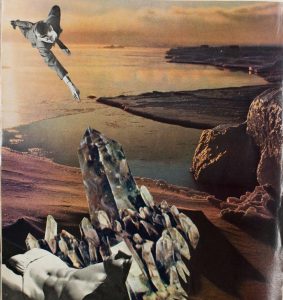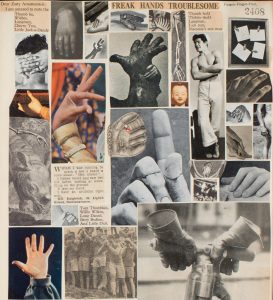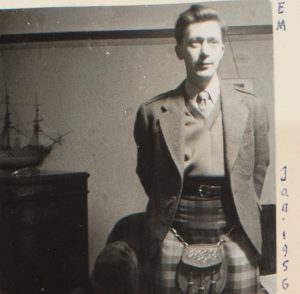Kerry Patterson, Project Officer for CREATe’s Digitising the Edwin Morgan Scrapbooks introduces her work to explore the extent to which EU and UK copyright policy impacts the digitisation of unique and distinctive artistic collections, such as the Morgan scrapbooks, as well as the costs associated with rights clearance.

Collage from Scrapbook 12
Digitising the Edwin Morgan Scrapbooks is a project led by CREATe in conjunction with Glasgow University’s Special Collections Department. Within the Archive of the poet Edwin Morgan (1920-2010) held at the University, are sixteen scrapbooks. These date from 1931 to 1966 and were used by Morgan as an outlet for his creative expression before poetry became his primary focus. Within the scrapbooks are around 3,600 pages in total, with material from a diverse range of sources; contemporary and historical newspapers, books and periodicals, photographs, stamps, advertisements, flyers, cigarette cards and other everyday items.
The tone of the scrapbooks varies through the thirty year period during which they were created. Some pages are Surrealist-like collages of images or collections of favourite literary passages; others group text and image around a theme or record the development of local and international news stories that caught the compiler’s attention. Friends and holidays are recorded through photographs and ephemera. Morgan described the scrapbooks as ‘partly documentary/historical, partly aesthetic, partly satirical and partly personal … a Whitmanian reflecting glass of “the world” [as] refracted through one personality’. You can see a selection of images on Flickr with commentary by Morgan’s biographer James McGonigal.
One indication of the importance that Morgan placed on the books is that he twice sought to publish the scrapbooks during his lifetime, without success. In 1953 when they comprised around 200 pages, he offered them to literary agents Christy and Moore. In the late 1980s, with a well-established reputation, he tried to interest his publisher Carcanet Press in producing the scrapbooks in their entirety. The proposal was dismissed due to the prohibitive costs of colour printing and rights clearance for the extensive third-party copyright material embedded within the scrapbooks. While each page is individually numbered and the sources of many newspaper and magazine cuttings are noted, most of the vast number of images are un-credited.

Page on the theme of ‘hands’ from Scrapbook 12
The project will explore the limits (and costs) of EU and UK copyright policy as it impacts the digitisation of unique and distinctive artistic collections, such as the Morgan scrapbooks. In particular, it interrogates the concept of diligent search within the new EU and UK Orphan Works schemes as it applies to such collections (IPO Guidelines).
The research questions addressed by this project are:
Q1: Given that mass digitisation projects involve large quantities of works and that institutions are faced with resource constraints, what are the costs (both direct and indirect) involved in clearing the rights to make available mixed-media archival works?
Q2: How onerous are current ‘diligent search’ requirements with respect to mixed-media works in the UK, and how do these criteria contribute to the cost-benefit calculation explored in Q1 above?
Q3: In light of the empirical evidence developed above, what considerations should inform orphan works legislation and institutional practice at the EU and UK level to balance the needs of institutions, users and stakeholders?

Portrait of Edwin Morgan, January 1956, from Scrapbook 12
Many collections in archives, museums and libraries across the UK possess material which presents similar challenges for copyright clearance in having multiple unknown authors. As users expect increasing amounts of material from these institutions to be available for online consultation, copyright law and the understanding of it continues to present a significant obstacle to digitisation. While institutions have a duty and a desire to provide access to their collections, the choice between digitising pre-20th Century material which is out of copyright or 20th Century material with complex copyright questions is often easy to make. Moreover, institutions do not wish to fall foul of the law nor to make a decision which would prove damaging to their reputation. Even selecting relevant images to illustrate a blog post about copyright is a difficult matter requiring a level of risk assessment.
Aspects of the project will be explored in future blog posts. You can find out more about the Edwin Morgan Archive on the Special Collections blog.

